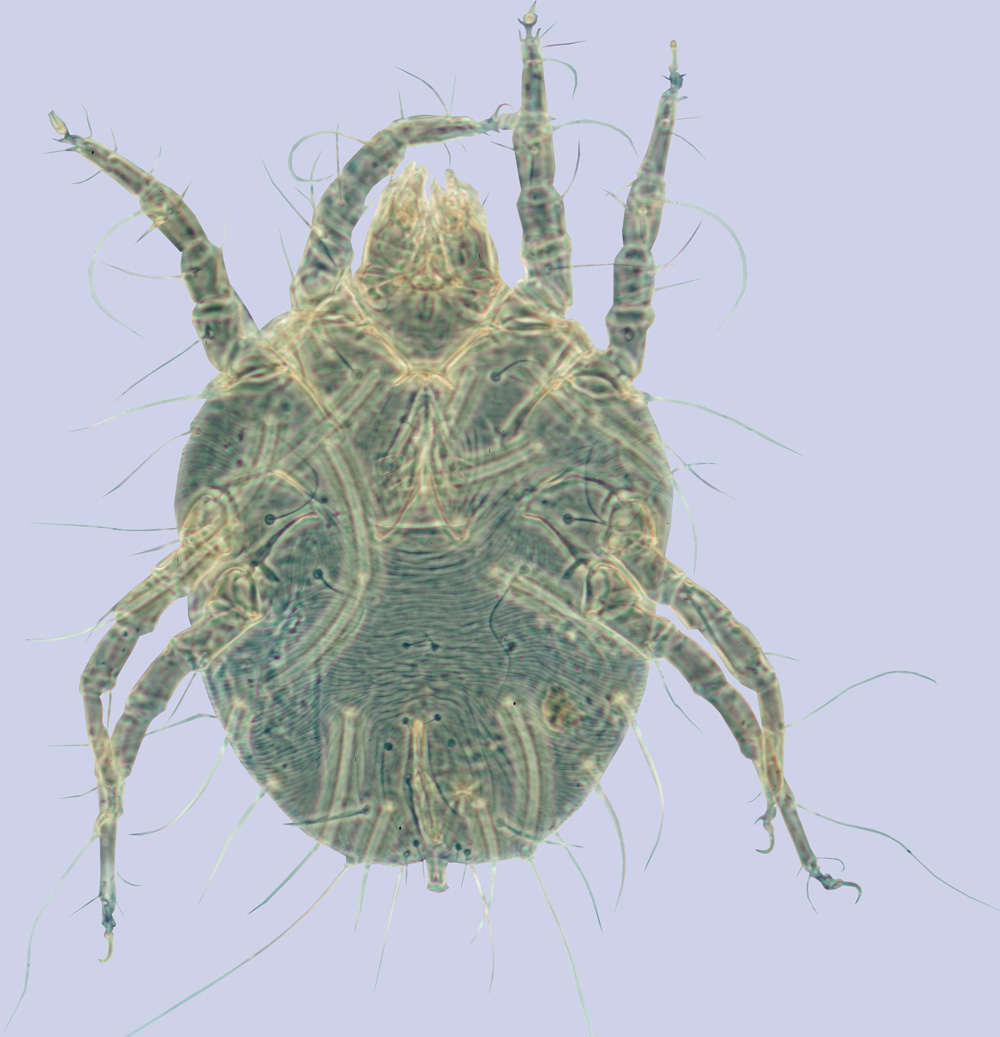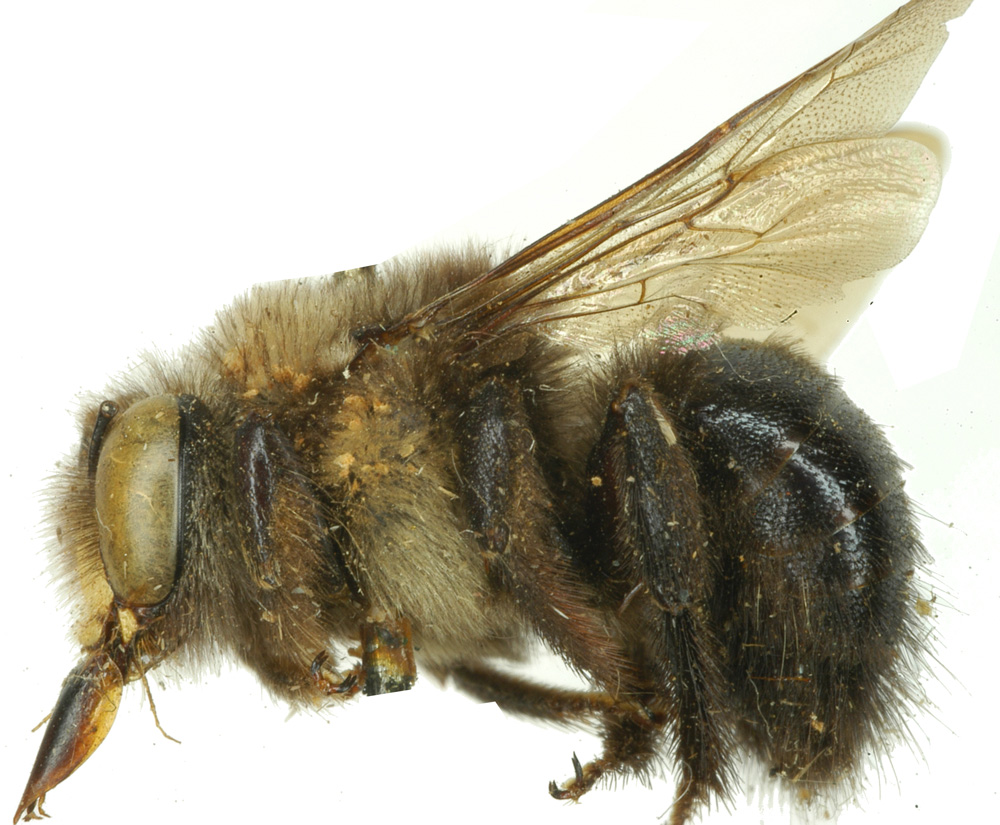Bee Mites : Acari : Acariformes : Sarcoptiformes : Chaetodactylidae : Sennertia : Sennertia species
Sennertia vaga Klimov and OConnor, 2008
Sennertia vaga Klimov and OConnor, 2008: 150, Figs 31-39.
Material (show database records). Holotype: f - USA: California, Los Angeles Co., Rustic Canyon, SM, on Lotus (Fabales: Fabaceae) (no 671), ex Xylocopa tabaniformis orpifex on mesosoma, 11 Apr 1955, R. S. Erdmann, LACM 208287, BMOC 04-1122-025; Paratypes: 1m, 6 TNs, 4PN's, 1L (same data as for holotype); 2f, 3m, 6TN, 5PN (on 11 slides) - Los Angeles Co., Claremont, ex Xylocopa t. orpifex on pronotum, no date, Baker, USNM, BMOC 05-0420-389; 6TNs, 8PNs - Arizona, Santa Cruz Co., Patagonia Mountains, ex X. californica on propodeum & posterior wing bases, 1 Jun 1917, Oslar, INHS Insect Collection 62340, BMOC 04-1222-003; 5 TNs - Santa Cruz Mts., Felton, 15-19 May 1907, J. C. Bradley, ex X. tabaniformis orpifex, CUIC HK 84-1217-002; 1m, 1f, 1TNs, 2PNs - MEXICO: Baja California Sur, 2 mi S La Paz , ex X. tabaniformis androleuca on dorsal mesosoma, 6 Aug 1966, J. A. Chemsak, P. D. Hurd & E. G. Linsley, USNM, BMOC 05-0420-387; 2m, 1f, 2TNs, 8PNs - Sinaloa, 15 mi N Los Mochis, ex X. t. androleuca on dorsal mesosoma, 28 Jul 1966, J. A. Chemsak, E. G. & J. M. Linsley, USNM, BMOC 05-0420-386. Holotype in LACM, paratypes in CUIC, INHS, LACM, UMMZ, UNAM, USNM.
Description. Phoretic and immobile deutonymph unknown, probably absent (see notes).
Adult. Supracoxal seta scx situated outside supracoxal sclerite, lateral to outer ridge of supracoxal sclerite. Alveoli of setae ve present. Dorsal idiosomal cuticle uniformly striate (striae may be with small tubercles). Dorsal cuticular pattern more or less uniform. Dorsal idiosomal setae c1-h1 filiform and long, reaching at least half of distance to next posterior pair of setae). Dorsal idiosomal setae cp, c3, h3 narrowing distally, not compressed dorso-ventrally, usually evenly barbed. Dorsal setae e2 and f2 filiform, nearly as long as h3. Prodorsal shield subquadrate, length/width 0.8-1.4. Prodorsal shield without falsifoveate pattern. Coxal fields III closed. Proximal acetabular extensions of ap' I partially border antiaxial margins of coxal fields I. Proximal acetabular extensions of ap' II partially border antiaxial margins of coxal fields II. Distal acetabular extensions of ap' II and ap'' II separate. Proximal acetabular extensions of ap' III partially border antiaxial margins of coxal fields III. Distal acetabular extensions of ap' III and ap'' III separate or not developed. Proximal acetabular extensions of ap' IV partially border antiaxial margins of coxal fields IV. Distal acetabular extensions of ap' IV and ap'' IV separate or not developed. Opisthosomal gland openings distinctly anterior to setae e2. Tarsal setae ra and la II absent. Solenidion ω2 I intermediate between subapical and submedial. Famulus ε lanceolate. Setae ba I as long as famulus ε or shorter. Setae ba II as long as famulus ε or shorter.
Female. Setae ad1 and ad2 present. Setae ps3 short, distinctly shorter than ps2; posterior to 4a level. External copulatory tube present. Setae h3 anterior to h2. Posterio-medial part of dorsal opisthosoma without distinct longitudinal linear pattern.
Male. Setae ad1 present. Genital setae spiniform; slightly (about on their diameter at base) anterior to progenital fold. Pseudanal setae ps3 outside progenital sclerites, filiform. Dorsal supporting sclerites short, as long as 2 diameters of aedeagus at base or shorter. Setae q I and p II present. Pretarsal suckers IV same as pretarsal suckers I-III.
Protonymph. Tarsal setae e IV absent; f IV present.
Larva. Proportional length of dorsal idiosomal setae as in other instars.
Hosts. Xylocopa (Notoxylocopa) tabaniformis orpifex, Xylocopa (Notoxylocopa) tabaniformis androleuca, Xylocopa (Xylocopoides) californica.
Distribution (Show map). USA: Arizona, California; Mexico: Baja California Sur, Sinaloa.
Etymology. Vagus is a Latin adjective (roving, wandering, doubtful).
Notes. This species probably does not form phoretic deutonymphs. In the southern Nearctic, it is associated with hosts that also harbor S. lucrosa and S. shimanukii and sometimes may be found with the former on the same bee specimen. A single pharate tritonymph of S. lucrosa (BMOC 05-0420-076) is substantially distinct from tritonymphs of S. vaga in having la and ra II developed and coxal fields III opened. Feeding instars of S. augustii (deutonymphs virtually undistinguishable from S. shimanukii) also have opened coxal fields III. The same situation was also detected for some Neotropic Centris that have phoretic feeding instars of a similar species and heteromorphic deutonymphs of Centriacarus turbator.
References
Klimov, P. B. & B. M. OConnor. 2008. Morphology, evolution, and host associations of bee-associated mites of the family Chaetodactylidae (Acari: Astigmata), with a monographic revision of North American taxa. Miscellaneous Publications Museum of Zoology University of Michigan.199: 1-243.
Image Gallery
B. OConnor and P. Klimov ©
Created: May 26, 2011
Last modified: 


